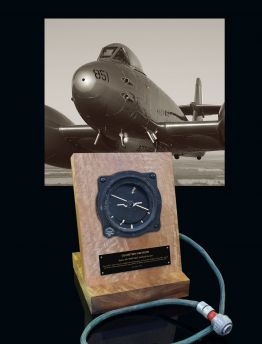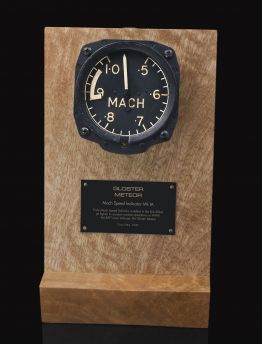- AUST POST SHIPPING
- 0438 654 235
- info@recoverycurios.com
- P.O. Box 7640 Cairns QLD Australia, 4870
-
0
Shopping Cart


GLOSTER METEOR
 The Gloster Meteor was the first British jet fighter and the Allies’ only jet aircraft to conduct combat operations during WWII.
The Gloster Meteor was the first British jet fighter and the Allies’ only jet aircraft to conduct combat operations during WWII.
First conceived in 1940, it’s progress was heavily dependent on the work  being conducted by British aeronautical engineer, Frank Whittle and his groundbreaking turbojet engines, which had been underway since 1936.
being conducted by British aeronautical engineer, Frank Whittle and his groundbreaking turbojet engines, which had been underway since 1936.
An all-metal aircraft with a tricycle undercarriage, low straight wings encompassing two, mid-mounted Rolls-Royce Weeland turbojet engines and a high-mounted tail plane clear of the jet exhaust, the aircraft’s design, production, and pilot training was shrouded in the highest secrecy.
 While 14 aircraft were delivered to RAF No. 616 Squadron in early January 1944, pilot conversion from the Squadron’s MkVIII Spitfires to the new jet fighters was not complete until mid July when 32 pilots had successfully made the transition from propeller to jet.
While 14 aircraft were delivered to RAF No. 616 Squadron in early January 1944, pilot conversion from the Squadron’s MkVIII Spitfires to the new jet fighters was not complete until mid July when 32 pilots had successfully made the transition from propeller to jet.
616 Squadron’s Meteors first saw action on the 4th of August when they were scrambled to intercept a number of V1 Flying bombs and recorded their first two ‘kills’. By the close of hostilities in Europe, Gloster Meteors had shot down 14 flying bombs.
 Almost eight months earlier the Luftwaffe’s new jet fighter the Messchersmitt ME 262 had dramatically announced its presence in the skies over Europe when it attacked a de Havilland Mosquito flying a reconnaissance mission. The heavily damaged Mosquito, with its badly shaken crew managed to reach the safety of an allied airfield in northern Italy but many other allied aircraft were not so lucky.
Almost eight months earlier the Luftwaffe’s new jet fighter the Messchersmitt ME 262 had dramatically announced its presence in the skies over Europe when it attacked a de Havilland Mosquito flying a reconnaissance mission. The heavily damaged Mosquito, with its badly shaken crew managed to reach the safety of an allied airfield in northern Italy but many other allied aircraft were not so lucky.
 The Me 262’s swept back wings and advanced pod-mounted, Junkers Jumo 004 turbojet engines gave the fighter jet an unmatched speed of over 540mph - 120mph faster than the most advanced propeller-driven US fighter - the P51 Mustang.
The Me 262’s swept back wings and advanced pod-mounted, Junkers Jumo 004 turbojet engines gave the fighter jet an unmatched speed of over 540mph - 120mph faster than the most advanced propeller-driven US fighter - the P51 Mustang.
With its R4M Hurricane Rockets and four 30mm cannons, the Me 262 went onto claim over 500 air victories and wreaked devastation on the tightly packed USAF bomber fleets.
The Me 262’s biggest drawback however was the instability and short operating life of its jet engines with each having an operational life of barely 12 - 25 hrs. The Gloster Meteor’s Rolls-Royce engines were considerably safer and far more reliable but while both jet fighters flew combat missions over the same period, they never met in the air.
 The primary reason for this was that the RAF were initially forbidden to operate the Meteor over German occupied territory for fear of it being shot down and falling into the hands of the enemy and it was not until January 1945 that the RAF finally deployed them on the continent at the Melsbroek base in Belgium as air protection for the US Second Tactical Air Force.
The primary reason for this was that the RAF were initially forbidden to operate the Meteor over German occupied territory for fear of it being shot down and falling into the hands of the enemy and it was not until January 1945 that the RAF finally deployed them on the continent at the Melsbroek base in Belgium as air protection for the US Second Tactical Air Force.
The war ended with the Meteors having destroyed 46 German aircraft through ground attack. Friendly fire through misidentification as Messerschmitt Me 262s by Allied anti-aircraft gunners was more of a threat than the already-diminished forces of the Luftwaffe; to counter this, the continental-based Meteors were given an all-over white finish for easier recognition.
 While the Gloster Meteor saw limited action in the Second World War, Meteors of the Royal Australian Air Force fought in the Korean War, with several other nations such as Argentina, Egypt and Israel flying Meteors in later regional conflicts.
While the Gloster Meteor saw limited action in the Second World War, Meteors of the Royal Australian Air Force fought in the Korean War, with several other nations such as Argentina, Egypt and Israel flying Meteors in later regional conflicts.
As radar technology developed, a new Meteor night fighter - the NF Series was developed to use the improved US-built APS-21 radar system but like any new technological aircraft advance, the Gloster Meteor was not without its ongoing problems - with many issues plaguing the fighter throughout its operational life.
 During its service with the RAF, a total of 890 Meteors were lost (145 of these crashes in 1953 alone) resulting in the deaths of 450 pilots.
During its service with the RAF, a total of 890 Meteors were lost (145 of these crashes in 1953 alone) resulting in the deaths of 450 pilots.
Contributory factors in the number of crashes were the poor brakes, landing gear failure, high fuel consumption and consequent short flight endurance (less than one hour), causing pilots to run out of fuel, and difficult handling with one engine out due to the widely set engines.
Pilot fatalities were further exacerbated by the lack of ejection seats in early series Meteors.
Pilots who had been veterans of bailouts from the slower propeller-driven aircraft suddenly found themselves subjected to overwhelming g forces from the Meteor’s ground-breaking high speeds, which pinned them back into their seats. Even if they did succeed in escaping the cockpit, the aircraft’s powerful slipstream often blew them back into the horizontal tail plane.
 With the arrival of the jet fighter age, safe bailouts became a significant challenge for aircraft designers and it was not until the introduction of the Martin Baker ejection seat and its retro fitting into later models of the Gloster Meteor that pilot fatalities began to fall.
With the arrival of the jet fighter age, safe bailouts became a significant challenge for aircraft designers and it was not until the introduction of the Martin Baker ejection seat and its retro fitting into later models of the Gloster Meteor that pilot fatalities began to fall.
By the late 1950s, the Gloster Meteor had already become obsolete as more nations introduced jet fighters, many of these newcomers having adopted a swept wing instead of the Meteor's conventional straight wing, which delivered greater maneuverability and faster dive and climbing speeds.
All Gloster Meteor Instruments listed below come complete with detailed Scale Model, Mango Wood Stand & Plaque plus Printed Fact Sheet featuring photo of instrument in aircraft cockpit.
Return to VINTAGE ORIGINAL AIRCRAFT INSTRUMENTS
- LAND
- SEA
- AIR
- VINTAGE ORIGINAL AIRCRAFT INSTRUMENTS
- HAWKER TYPHOON
- VICKERS WELLINGTON
- FAIREY GANNET
- RYAN ST-A SPORTS TRAINER
- DE HAVILLAND TIGER MOTH
- HAWKER HUNTER
- Mc DONNELL DOUGLAS KC-10 AERIAL TANKER
- SOPWITH CAMEL
- AIRCO DH.1 AND DH.2
- JUNKERS JU 87
- CURTISS C-46 COMMANDO
- HANDLEY PAGE HAMPDEN
- SUPERMARINE SEAFIRE
- B-25 MITCHELL BOMBER
- BRISTOL BLENHEIM
- ENGLISH ELECTRIC LIGHTNING
- HAWKER TEMPEST MkVI
- YAKOVELOV YAK - 3
- FOCKE-WULF FW190
- FOLLAND GNAT
- AIRSPEED OXFORD
- SHORT STIRLING
- AVRO ANSON
- DOUGLAS C-133 CARGOMASTER
- HANDLEY PAGE VICTOR BOMBER
- DE HAVILLAND SEA VENOM
- VICKERS VALIANT BOMBER
- DOUGLAS A-26 INVADER
- GRUMMAN S2F TRACKER
- SUPERMARINE SPITFIRE
- LOCKHEED P2-V NEPTUNE
- P-51 MUSTANG
- BRISTOL BEAUFIGHTER
- DE HAVILLAND MOSQUITO
- B-26 MARTIN MARAUDER
- P3 ORION
- DOUGLAS A-20 HAVOC
- P-39 AIRACOBRA
- AVRO SHACKLETON
- B-17 FLYING FORTRESS
- B-24 LIBERATOR
- MESSERSCHMITT BF-110
- MESSERSCHMITT BF-109
- BRISTOL BEAUFORT
- KAWASAKI Ki-45 (NICK) INTERCEPTOR
- C-130 HERCULES
- CAC BOOMERANG
- AVRO LANCASTER
- GRUMMAN F4F WILDCAT
- F4U VOUGHT CORSAIR
- WESTLAND LYSANDER
- P-47 REPUBLIC THUNDERBOLT
- NORTH AMERICAN T-6 TEXAN - HAVARD
- C-47 SKYTRAIN
- DOUGLAS SBD DAUNTLESS
- CAC WIRRAWAY
- PBY CATALINA
- P-40 WARHAWK
- FAIREY SWORDFISH
- P-38 LIGHTNING
- HAWKER HURRICANE
- CURTISS SB2C HELLDIVER
- GRUMMAN F6F HELLCAT
- SEAKING HELICOPTER
- SEAHAWK HELICOPTER
- DOUGLAS A4G SKYHAWK
- GRUMMAN TBF AVENGER
- HANDLEY PAGE HALIFAX
- DOUGLAS SKYRAIDER AE-1
- GLOSTER METEOR
- JUNKERS JU-88
- F-86 SABRE JET
- SHORT SUNDERLAND
- B-29 SUPER FORTRESS
- F-9F GRUMMAN PANTHER
- F-100D SUPER SABRE
- BELL UH-1 HUEY HELICOPTER
- AVRO VULCAN STRATEGIC BOMBER
- CANBERRA BOMBER
- DHC-4 CARIBOU
- BLACKBURN BUCCANEER
- DE HAVILLAND VAMPIRE JET
- HAWKER SEA FURY
- LOCKHEED HUDSON
- LOCKHEED EC-121 WARNING STAR
- SEPECAT JAGUAR
- HAWKER SIDDELEY NIMROD
- HAWKER SIDDELEY HARRIER
- ARADO AR 196
- VOUGHT OS2U KINGFISHER
- LOCKHEED ELECTRA
- NORTHROP P-61 BLACK WIDOW
- BOEING CH-47 CHINOOK
- LOCKHEED PV-1 VENTURA
- BOEING P26-A 'PEASHOOTER'
- Ilyushin Il-2 ‘Sturmovik’
- WESTLAND WESSEX
- FAIREY FIREFLY
- VINTAGE AVIATION COLLECTABLES
- VINTAGE COLLECTABLE MODEL AIRCRAFT KITS
- RETRO STYLE METAL AIRCRAFT COLLECTABLES
- VINTAGE ORIGINAL AIRCRAFT INSTRUMENTS





